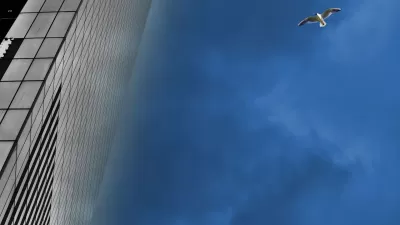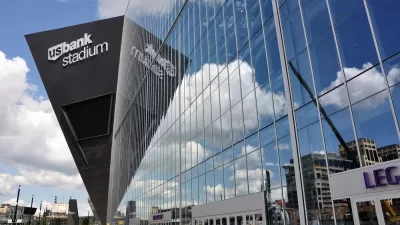Reflective glass high-rises kill millions of birds each year, but bird-friendly design can save birds and reduce energy consumption.

Architects know how to stop birds from flying into buildings, writes Alexandra Lange—but "those standards clash with the big glass and big views that clients associate with big money." To prevent birds from mistaking reflective glass windows for trees or open space, designers can use patterned glass, exterior screens, and reduced lighting. But according to Kate Orff of architecture and design studio SCAPE, an emphasis on giant glass panes has turned Manhattan into "a giant bird killer."
During last September's fall migration season, volunteers with NYC Audubon's collision monitoring project documented hundreds of bird strikes at the World Trade Center, and a heightened interest in birdwatching during the pandemic has led more people to pay attention to, and want to save, urban birds.
In early 2021, New York City implemented legislation that mandates bird-friendly design in new buildings and requires city buildings to turn off nonessential lighting at night during migration season.
The best example of a bird-safe retrofit, from the point of view of scale and effectiveness, is Manhattan’s Javits Center, which spent five years replacing the convention center’s clear glass with panels covered in tiny ceramic dots as part of a $500 million environmental retrofit that also added a 6.75-acre green roof. Almost imperceptible to the human eye, those dots nonetheless cut bird death by 90% — and energy consumption by 26%.
The article points out that bird collisions don't just happen with high-rise buildings, but there are low-cost changes homeowners can make to reduce bird strikes at home, such as safety netting or patterned window films.
FULL STORY: Buildings Don't Have To Be Bird-Killers

Alabama: Trump Terminates Settlements for Black Communities Harmed By Raw Sewage
Trump deemed the landmark civil rights agreement “illegal DEI and environmental justice policy.”

Planetizen Federal Action Tracker
A weekly monitor of how Trump’s orders and actions are impacting planners and planning in America.

Why Should We Subsidize Public Transportation?
Many public transit agencies face financial stress due to rising costs, declining fare revenue, and declining subsidies. Transit advocates must provide a strong business case for increasing public transit funding.

Understanding Road Diets
An explainer from Momentum highlights the advantages of reducing vehicle lanes in favor of more bike, transit, and pedestrian infrastructure.

New California Law Regulates Warehouse Pollution
A new law tightens building and emissions regulations for large distribution warehouses to mitigate air pollution and traffic in surrounding communities.

Phoenix Announces Opening Date for Light Rail Extension
The South Central extension will connect South Phoenix to downtown and other major hubs starting on June 7.
Urban Design for Planners 1: Software Tools
This six-course series explores essential urban design concepts using open source software and equips planners with the tools they need to participate fully in the urban design process.
Planning for Universal Design
Learn the tools for implementing Universal Design in planning regulations.
Caltrans
Smith Gee Studio
Institute for Housing and Urban Development Studies (IHS)
City of Grandview
Harvard GSD Executive Education
Toledo-Lucas County Plan Commissions
Salt Lake City
NYU Wagner Graduate School of Public Service





























